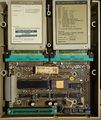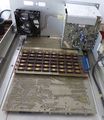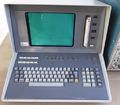4051: Difference between revisions
No edit summary |
(Added some more pictures) |
||
| Line 38: | Line 38: | ||
Tek_4051_roms.jpg|ROMs cloaseup | Tek_4051_roms.jpg|ROMs cloaseup | ||
Tek_WP1110_01.jpg|4051 with connected [[P7001|DPO]] - [[SPS|WP1110]] | Tek_WP1110_01.jpg|4051 with connected [[P7001|DPO]] - [[SPS|WP1110]] | ||
Tek_WP1110_front.jpg|4051 with connected [[P7001|DPO]] - [[SPS|WP1110]] | |||
Tek_4051_back_01.jpg|Back side | |||
Tek_4051_back_02.jpg|Back side detailled view | |||
Tek_4051_back_02.jpg|Back side detailled view | |||
Tek_4051_back_03.jpg|Back side detailled view | |||
Tek_4051_front_01.jpg|Front view | |||
Tek_4051_keyboard_01.jpg|Keyboard | |||
</gallery> | </gallery> | ||
Revision as of 05:50, 19 September 2020

The Tektronix 4051 was a graphics-capable desktop microcomputer produced by Tektronix in the late 1970s through the early 1980s. The display technology was similar to the Tektronix 4010 terminal, using a direct-view storage CRT display (like an analog storage scope) to avoid the need for video RAM. It was all-in-one design with the display, keyboard, CPU and a 300 kByte DC300 quarter-inch cartridge tape drive in a single desktop case, and included a GPIB interface. A simple operating system and BASIC interpreter were included in ROM.
The storage tube display allowed the screen to retain images drawn to it, eliminating the need for frame-buffer memory. This allowed the resolution to be as high as the hardware could handle, which was ostensibly 1024 by 1024 but limited by the physical layout of the screen to 1024 by 780. It also allowed the machine to dedicate all of its memory to the programs running on it, as opposed to partitioning off a section for the buffer.
The 4051 was based on an 8-bit Motorola 6800 CPU running at 1 MHz, and normally shipped with 8 kB of RAM expandable to 32 kB using 8 kB modules. The remaining 32 kB of address space was reserved for ROM, which could be expanded using one or two external ROM cartridges of 8 kB each. It included six character sets in ROM and an extended dialect of BASIC that included various vector drawing commands.
The 4051 was released in 1975 for the base price of $5,995 (2016 value $26,900). Adding the optional RS-232 interface allowed it to emulate a Tektronix 4012 terminal.
Key designer of the 4051 was Hiro Moriyasu.
See Also
Links
- Tektronix 4051 Brochure (PDF)
- 4050 series manuals @ bitsavers
- Tektronix 4050 series at Wikipedia
- Tekscope 1975 Vol.7 No.5: A desk-top graphic computing system
- 4051 leaflet from 1976
- 4051 @ tekmuseum.com
- 4051 @ Dalby Datormuseum
- Tek 4051 at work @ YouTube
- Signal Processing Cartridge Number 1
- Signal Processing Cartridge Number 2
-
Communication Interface
-
Communication Interface
-
Communication Interface
-
Inside view
-
RAM board
-
main board
-
Screen without frame
-
Power supply
-
Power supply
-
ROMs cloaseup
-
Back side
-
Back side detailled view
-
Back side detailled view
-
Back side detailled view
-
Front view
-
Keyboard
















